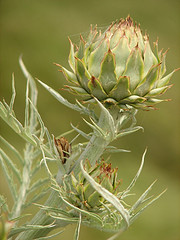Artichoke
| Infobox on Artichoke | |
|---|---|
| Example of Artichoke |  |
| Freshness facts | |
| Optimum carrying temperature | 0°C / +1°C |
| Highest freezing point | -1,2°C |
| Acceptable product temp. at loading into containers | Max. 2°C above carrying temperature |
| Optimum humidity | >95% |
| Ventilation setting for containers | 10 m³/hr |
| Storage life | 3-7 weeks |
| Climacteric / non-climacteric | Non-climacteric |
| Ethylene production | Very low |
| Ethylene sensitivity | Low |
| Modified / controlled atmosphere | 2%-3% O2; 2%-5% CO2 |
| Potential benefits | Moderate |
| Availability | |
| Cyprus Egypt France Greece Israel Italy Lebanon Morocco Spain UK |
November - May December - April March - November April - May January - March December - May May - August December - May November - June March - May |
Artichoke
Contents
Harvesting and Handling
The edible portion of an artichoke includes the tender immature flower bud and fleshy central base that is protected by a cone of short, thick-stemmed bracts. The main types include Green Globe, Desert Globe Imperial Star, Emerald and Big Heart.
A high quality artichoke will have tightly closed, turgid outer bracts without signs of black tip, blistering or browning. They should be medium to dark glossy green in color and some cultivars may have a magenta color at the base of each bract. The artichoke should not be soft when squeezed and feel heavy for their size. Both thorny and thornless cultivars are used commercially.
The outer bracts of an artichoke ready for harvest should be tightly closed, firm and turgid. They are harvested when immature and selected based on size and compactness.
Moisture loss can be minimized by cooling adequately and packing artichokes in waxed cartons or in cartons lined with perforated plastic film.
Splitting of the bract tip is a common problem caused by rough handling during and after harvest. The surfaces of bracts are also easily bruised and scratched. The abraded areas usually turn brown or black, which greatly detracts from appearance and quality, and provide a route through which microorganisms can enter.
Cooling and Storage
In order to maintain quality and storage-life, artichoke buds should be pre-cooled to below 5°C within 24 hours of harvest. Hydro-cooling, forced-air cooling and package-icing are common methods of postharvest cooling of artichokes and will generally retard deterioration such as discolouration, weight loss and decay.
Freezing injury will be initiated at - 1.2°C. Symptoms of light freezing injury are blistering of the cuticle and a bronzing of the outer bracts. This may occur in the field with winter harvested buds and is used in marketing as an index of high quality. More severe freeze injury results in watersoaked bracts and the heart becoming brown to black and gelatinous in appearance over time.
Mixed loads
Artichokes can be shipped in mixed loads at 0° to 5°C for durations shorter than two weeks.
Controlled atmosphere considerations
Controlled or modified atmospheres show moderate to little benefit to sustaining artichoke quality when stored at 0°C. Conditions of 2%-3% O2 and 2%-5% CO2 delay discolouration of bracts and the onset of decay by a few days at temperatures around 5°C. Atmospheres below 2% O2 may result in internal blackening of artichokes. However, in most cases, low temperature and high humidity (>95%) will ensure better quality than use of CA/MA.
Storage disorders
Bacterial rots, Blackening, Downy mildew, Chilling injury, Grey mould rot, Powdery mildew.











